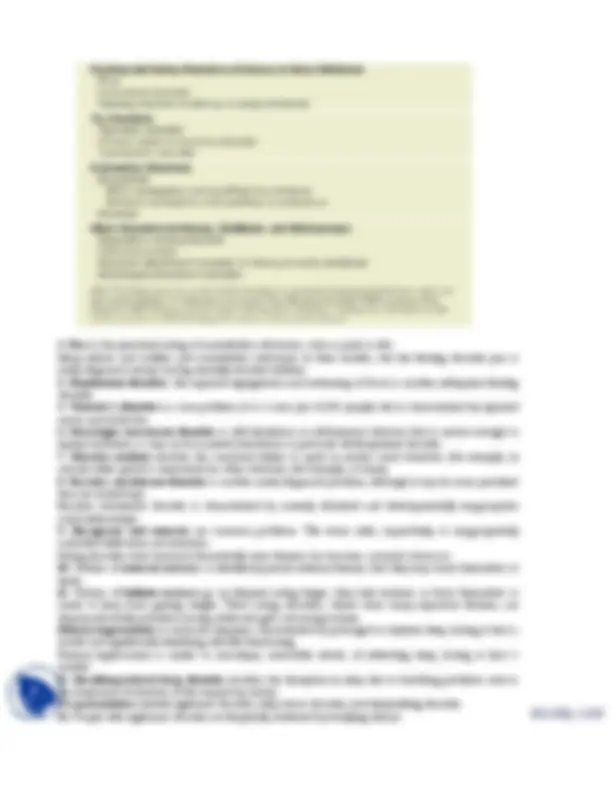




Study with the several resources on Docsity

Earn points by helping other students or get them with a premium plan


Prepare for your exams
Study with the several resources on Docsity

Earn points to download
Earn points by helping other students or get them with a premium plan
Community
Ask the community for help and clear up your study doubts
Discover the best universities in your country according to Docsity users
Free resources
Download our free guides on studying techniques, anxiety management strategies, and thesis advice from Docsity tutors
This course points out abnormal behavior reasons and its forms. Mostly it talks about amnestic disorder, mood disorder, developmental disorder, genetics, personality disorder, problems in childhood, psychological model, stress, substance disorder. This lecture includes: Developmental, Psychopathology, Externalizing, Internalizing, Oppositional, Conduct, Childhood, Hyperactivity, Encopresis, Breathing
Typology: Exercises
1 / 4

This page cannot be seen from the preview
Don't miss anything!



Developmental Psychopathology approach is absolutely essential to disorders of childhood, because children change rapidly during the first 20 years of life. Psychologists become concerned only when a child’s behavior deviates substantially from developmental norms, behavior that is typical for children of a given age.
Psychological problems that commonly begin during childhood are listed in the DSM-IV-TR category Disorders Usually First Diagnosed in Infancy, Childhood, or Adolescence. Other than mental retardation and pervasive developmental disorders, the most important disorders in this category are the various externalizing disorders. Two kinds of disorders 1- Externalizing Disorders 2- Internalizing Disorders
1- Externalizing Disorders Externalizing disorders create difficulties for the child’s external world. Externalizing disorders are characterized by children’s failure to control their behavior according to the expectations of parents, peers, teachers, and/or legal authorities—for example, as a result of hyperactive behavior or conduct problems.
Kinds of Pervasive Developmental Disorder i. Autistic Disorder ii. Attention Deficit Hyperactivity Disorder (ADHD) iii. Oppositional Deficit Disorder (ODD) iv. Conduct Disorder v. Asperger’s Disorder vi. Childhood Disintegrative Disorder vii. Rett’s Disorder
Symptoms of Externalizing Disorders Many externalizing symptoms involve violations of age-appropriate social rules, including disobeying parents or teachers, violating social or peer group norms (e.g., annoying others), and perhaps violating the law.
Some misconduct is normal, perhaps even healthy, for children. However, the rule violations in externalizing disorders are not trivial and are far from “cute.” Externalizing behavior is a far greater concern when it is frequent, intense, lasting, and pervasive.
2- Internalizing Disorders Internalizing disorders are psychological problems that primarily affect the child’s internal world—for example, excessive anxiety or sadness. DSM-IV-TR does not list internalizing disorders as separate psychological disorders of childhood; rather, the manual notes that children may qualify for many “adult” diagnoses, such as anxiety or mood disorders.
Symptoms of Internalizing Disorders Children’s internalizing symptoms include sadness, fears, and somatic complaints, as well as other indicators of mood and anxiety disorders—for example, feeling worthless or tense. DSM-IV-TR does not have a separate category for children’s internalizing disorders, but the manual does identify some unique ways in which children experience the symptoms. In assessing children’s internalizing problems, mental health professionals must obtain information
When assessing children directly, child clinical psychologists are sensitive to different signs that may be indicative of depression at different ages. Depression in children and adolescents often is comorbid both with externalizing problems and with anxiety. Three findings from fear research are important to note.
Kinds of Internalizing Disorders 1- DSM-IV-TR contains a diagnosis for separation anxiety disorder , which is defined by symptoms such as persistent and excessive worry for the safety of an attachment figure, fears of getting lost or being kidnapped, nightmares with separation themes, and refusal to be alone. Separation anxiety disorder is especially problematic when it interferes with school attendance. 2- School refusal, also known as school phobia, is characterized by an extreme reluctance to go to school, and is accompanied by various symptoms of anxiety, such as stomachaches and headaches. Children with internalizing or externalizing problems often have troubled peer relationships. In 1896, the psychologist Lightner Witmer established the first psychological clinic for children in the United States. Despite the early origins of child clinical psychology, children were largely ignored in early classifications of mental disorders. DSM-I contained only two separate diagnoses for children, and DSM-II listed only seven childhood disorders. DSM-III recognized a much wider range of childhood disorders, and in fact, contained a proliferation of diagnostic categories, 40 in all. Although laudable, the new effort was overly ambitious. Many of the new diagnoses were severely criticized and subsequently were dropped.
14- Sleep terror disorder also involves abrupt awakening from sleep, typically with a scream, but it differs from nightmare disorder in important respects. 15- Sleepwalking disorder involves rising from the bed during sleep and walking about in a generally unresponsive state. Occasional episodes of sleepwalking are fairly common, especially among children. Like all sleep disorders, sleepwalking disorder tends to be diagnosed only if it causes significant distress or impairs the person’s ability to function. Many listed childhood disorders not in fact mental disorders. Child’s behavior is intimately linked with the family, school, and peer contexts. Because of this, some experts have suggested that diagnosing individual children is misleading and misguided. Instead, children’s psychological problems could be classified within the context of key relationships, particularly the family.
Frequency of Internalizing Disorders
Treatment of Internalizing Disorders